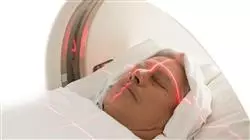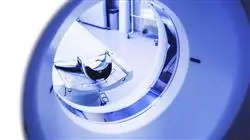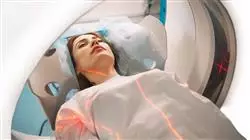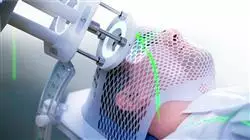University certificate
The world's largest faculty of medicine”
Introduction to the Program
You will master digital image processing thanks to the best digital university in the world, according to Forbes"

The Compton Effect is one of the most important processes to keep in mind when calculating radiation dose in treatments. The reasons lie in the implications it has on the generation of medical images and radiation dosage in different therapies. If experts were to make mistakes when measuring this process, this would lead to everything from incorrect diagnoses to radiation overdosage. This, in turn, could lead to side effects and damage to normal tissues.
In order to obtain proper education on fabric composition and density, TECH has implemented this advanced Postgraduate diploma. In this way, nurses will be able to carry out safe clinical practices, using both X-Ray and Gamma Rays. In fact, the curriculum will address the interactions between photons and matter.
It will also delve into the weighting factors of organs according to their radiosensitivity, analyzing various tools for quality control in visualization systems. This will allow the graduate to identify the risks in the hospital area and to design structural shielding for the protection of both patients and personnel.
In order to consolidate these contents, the methodology of this program reinforces its innovative character. In this way, TECH offer a 100% online educational environment. to the needs of busy professionals looking to advance their careers. In addition, it will employ the Relearning methodology, based on the repetition of key concepts to fix knowledge and facilitate learning. In this way, the combination of flexibility and a robust pedagogical approach makes it highly accessible. In addition, learners will have access to an extensive library of innovative multimedia resources in different audiovisual formats, such as interactive summaries, explanatory videos, photographs, case studies and infographics.
You will delve into the interaction between photons and matter to irradiate tumors with high precision"
This Postgraduate diploma in Radiophysics Applied to Diagnostic Imaging contains the most complete and up-to-date scientific program on the market. The most important features include:
- The development of case studies presented by experts in Radiophysics applied to Diagnostic Imaging
- The graphic, schematic and practical contents with which it is conceived gather scientific and practical information on those disciplines that are essential for professional practice
- Practical exercises where the self-assessment process can be carried out to improve learning
- Its special emphasis on innovative methodologies
- Theoretical lessons, questions to the expert, debate forums on controversial topics, and individual reflection assignments
- The availability of access to content from any fixed or portable device with an Internet connection
Looking to get the most out of Mammography equipment? Develop the most advanced tests in quality control, thanks to TECH"
The program’s teaching staff includes professionals from the sector who contribute their work experience to this program, as well as renowned specialists from leading societies and prestigious universities.
The multimedia content, developed with the latest educational technology, will provide the professional with situated and contextual learning, i.e., a simulated environment that will provide immersive education programmed to learn in real situations.
This program is designed around Problem-Based Learning, whereby the professional must try to solve the different professional practice situations that arise during the academic year For this purpose, the students will be assisted by an innovative interactive video system created by renowned and experienced experts.
You will cover dosimeter calibration in detail to ensure reliable radiation exposure measurements"

With the Relearning system, pioneer in TECH, you will reduce long hours of study and memorization"
Syllabus
The program is distinguished by its comprehensive structure and dynamic content. In fact, its design is composed of modules that will cover everything from radiation interactions with matter to dosimetry and radiation protection, thus covering every essential aspect of quality medical imaging. With an updated and applied approach, this program will offer theoretical knowledge, supported by the latest technology used in real radiodiagnostic facilities. In addition, it will include a detailed analysis of radiological protection, a key element to ensure the safety of both medical staff and patients.

Get specialized through this comprehensive curriculum, as well as the guidance of the best professionals in the field of Hospital Radiophysics”
Module 1. Interaction of Ionizing Radiation with Matter
1.1. Radiation Ionizing-Matter Interaction
1.1.1. Ionizing Radiation
1.1.2. Collisions
1.1.3. Braking Power and Range
1.2. Charged Particle-Matter Interaction
1.2.1. Fluorescent Radiation
1.2.1.1. Characteristic Radiation or X-rays
1.2.1.2. Auger Electrons
1.2.2. Braking Radiation
1.2.3. Spectrum upon Collision of Electrons with a High Z Material
1.2.4. Electron-positron Annihilation
1.3. Photon-Matter Interaction
1.3.1. Attenuation
1.3.2. Hemireductive Layer
1.3.3. Photoelectric Effect
1.3.4. Compton Effect
1.3.5. Pair Creation
1.3.6. Predominant Effect according to Energy
1.3.7. Imaging in Radiology
1.4. Radiation Dosimetry
1.4.1. Charged Particle Equilibrium
1.4.2. Bragg-Gray Cavity Theory
1.4.3. Spencer-Attix Theory
1.4.4. Absorbed Dose in Air
1.5. Magnitudes in Radiation Dosimetry
1.5.1. Dosimetric Quantities
1.5.2. Radiation Protection Quantities
1.5.3. Radiation Weighting Factors
1.5.4. Weighting Factors of Organs according to their Radiosensitivity
1.6. Detectors for the Measurement of Ionizing Radiation
1.6.1. Ionization of Gases
1.6.2. Excitation of Luminescence in Solids
1.6.3. Dissociation of Matter
1.6.4. Detectors in the Hospital Setting
1.7. Dosimetry of Ionizing Radiation
1.7.1. Environmental Dosimetry
1.7.2. Area Dosimetry
1.7.3. Personal Dosimetry
1.8. Thermoluminescence Dosimeters
1.8.1. Thermoluminescence Dosimeters
1.8.2. Calibration of Dosimeters
1.8.3. Calibration at National Dosimetry Center
1.9. Physics of Radiation Measurement
1.9.1. Value of a Quantity
1.9.2. Accuracy
1.9.3. Precision
1.9.4. Repeatability
1.9.5. Reproducibility
1.9.6. Traceability
1.9.7. Quality in the Measurement
1.9.8. Quality Control of an Ionization Chamber
1.10. Uncertainty in Radiation Measurement
1.10.1. Uncertainty in the Measurement
1.10.2. Tolerance and Action Level
1.10.3. Type A Uncertainty
1.10.4. Type B Uncertainty
Module 2. Advanced Diagnostic Imaging
2.1. Advanced Physics in X-Ray Generation
2.1.1. X-ray Tubes
2.1.2. Radiation Spectra Used in Radiodiagnosis
2.1.3. Radiological Technique
2.2. Imaging in Radiology
2.2.1. Digital Image Recording Systems
2.2.2. Dynamic Imaging
2.2.3. Radiodiagnostic Equipment
2.3. Quality Control in Radiodiagnostics
2.3.1. Quality Assurance Program in Radiodiagnosis
2.3.2. Quality Protocols in Radiodiagnostics
2.3.3. General Quality Control Checks
2.4. Patient Dose Estimation in X-Ray Installations
2.4.1. Patient Dose Estimation in X-Ray Installations
2.4.2. Patient Dosimetry
2.4.3. Diagnostic Dose Reference Levels
2.5. General Radiology Equipment
2.5.1. General Radiology Equipment
2.5.2. Specific Quality Control Tests
2.5.3. Doses to Patients in General Radiology
2.6. Mammography Equipment
2.6.1. Mammography Equipment
2.6.2. Specific Quality Control Tests
2.6.3. Dose to Patients in Mammography
2.7. Fluoroscopy Equipment. Vascular and Interventional Radiology
2.7.1. Fluoroscopy Equipment
2.7.2. Specific Quality Control Tests
2.7.3. Dose to Patients in Interventions
2.8. Computed Tomography Equipment
2.8.1. Computed Tomography Equipment
2.8.2. Specific Quality Control Tests
2.8.3. Dose to Patients in CT
2.9. Other Radiodiagnostics Equipment
2.9.1. Other Radiodiagnostics Equipment
2.9.2. Specific Quality Control Tests
2.9.3. Non-ionizing Radiation Equipment
2.10. Radiological Image Visualization Systems
2.10.1. Digital Image Processing
2.10.2. Calibration of Display Systems
2.10.3. Quality Control of Visualization Systems
Module 3. Radiation Protection in Hospital Radioactive Facilities
3.1. Radiation Protection in Hospitals
3.1.1. Radiation Protection in Hospitals
3.1.2. Radiological Protection Magnitudes and Specialized Radiation Protection Units
3.1.3. Risks in the Hospital Area
3.2. International Radiation Protection Standards
3.2.1. International Legal Framework and Authorizations
3.2.2. International Regulations on Health Protection against Ionizing Radiation
3.2.3. International Regulations on Radiological Protection of the Patient
3.2.4. International Regulations on the Specialty of Hospital Radiophysics
3.2.5. Other International Regulations
3.3. Radiation Protection in Hospital Radioactive Facilities
3.3.1. Nuclear Medicine
3.3.2. Radiodiagnostics
3.3.3. Radiotherapy Oncology
3.4. Dosimetric Control of Exposed Professionals
3.4.1. Dosimetric Control
3.4.2. Dose Limits
3.4.3. Personal Dosimetry Management
3.5. Calibration and Verification of Radiation Protection Instrumentation
3.5.1. Calibration and Verification of Radiation Protection Instrumentation
3.5.2. Verification of Environmental Radiation Detectors
3.5.3. Verification of Surface Contamination Detectors
3.6. Tightness Control of Encapsulated Radioactive Sources
3.6.1. Tightness Control of Encapsulated Radioactive Sources
3.6.2. Methodology
3.6.3. International Limits and Certificates
3.7. Design of Structural Shielding in Medical Radioactive Facilities
3.7.1. Design of Structural Shielding in Medical Radioactive Facilities
3.7.2. Important Parameters
3.7.3. Thickness Calculation
3.8. Structural Shielding Design in Nuclear Medicine
3.8.1. Structural Shielding Design in Nuclear Medicine
3.8.2. Nuclear Medicine Facilities
3.8.3. Calculation of the Workload
3.9. Structural Shielding Design in Radiotherapy
3.9.1. Structural Shielding Design in Radiotherapy
3.9.2. Radiotherapy Facilities
3.9.3. Calculation of the Workload
3.10. Structural Shielding Design in Radiodiagnostics
3.10.1. Structural Shielding Design in Radiodiagnostics
3.10.2. Radiodiagnostics Facilities
3.10.3. Calculation of the Workload

You will face emerging challenges in Applied Radiophysics for Diagnostic Imaging, continuously improving diagnostic processes and radiological safety in the hospital setting”
Postgraduate Diploma in Radiophysics Applied to Diagnostic Imaging
Radiophysics applied to diagnostic imaging focuses on the application of physical principles and advanced techniques to ensure quality and safety in diagnostic imaging procedures. Would you like to specialize in this innovative field? TECH Global University has the ideal option for you: the Postgraduate Diploma in Radiophysics Applied to Diagnostic Imaging. This online program will provide you with an in-depth understanding of the physical principles that drive diagnostic imaging technologies. You will delve into the physical principles that govern the formation of medical images using various technologies, from radiography to magnetic resonance imaging. In addition, you will learn about the most advanced equipment and technologies used in diagnostic imaging. From computed tomography (CT), to ultrasound and magnetic resonance imaging systems, you will be guided through the unique characteristics of each modality and their application in clinical practice.
Learn about radiophysics applied to diagnostic imaging
Only at TECH will you find the most up-to-date methods in the field, complemented by multimedia material and completely new dynamic classes. As you advance through the training, you will be immersed in image quality and dosimetry optimization. You will explore techniques and practices to ensure high-quality diagnostic images while minimizing radiation exposure, ensuring safe and accurate procedures. In addition, you will understand the principles of dosimetry specific to diagnostic radiology, gaining tools to measure and calculate the radiation dose delivered during diagnostic procedures, contributing to the safety and efficacy of studies. Finally, you will explore both quality control and radiation safety in diagnostic imaging, as well as technological developments and current trends in the field of radiophysics applied to diagnostic imaging. Upon completion, you will be ready to lead the field of diagnostic imaging. This program will equip you with advanced knowledge and specialized skills to contribute to the advancement and excellence in the science behind medical imaging. Enroll now and take your career to the next level!







